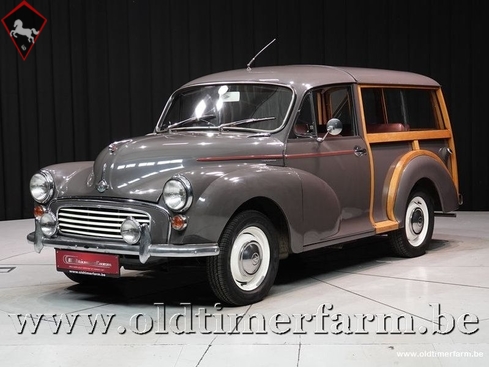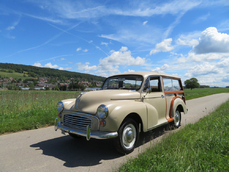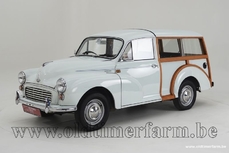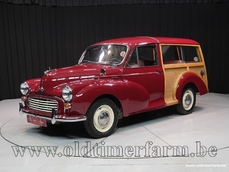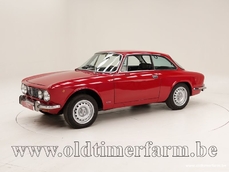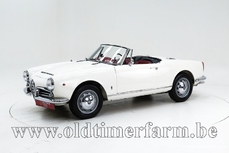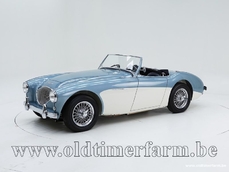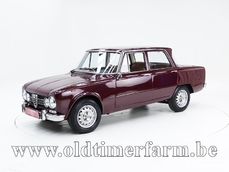Morris Minor Traveller '67 1967
General description :
The original Minor MM series lasted from 1948–1953. It included a pair of 4-seat saloons, 2-door and 4-door, and a convertible 4-seat Tourer. The front torsion bar suspension was shared with the larger Morris Oxford, as was the almost-unibody construction. Although the Minor was originally designed to accept a flat-4 engine, with four distinctive gaps in the engine bay to accommodate it, late in the development stage it was replaced by a 918 cc (56.0 cu in) side-valve straight-4 producing 27.5 hp (21 kW) and 39 lbf•ft (53 N•m) of torque. This little engine pushed the Minor to just 64 mph (103 km/h) but delivered 40 miles per imperial gallon (7.1 L/100 km; 33 mpg-US). Early cars had a painted section in the centre of the bumpers to cover the widening of the production car from the prototypes. This widening of 4 inches (102 mm) is also visible in the creases in the bonnet. Exports to the United States began in 1949 with the headlamps removed from within the grille to be mounted higher on the wings to meet safety regulations. These became standard on all Minors for 1951. When production of the first series ended, just over a quarter of a million had been sold with a surprising 30% being the convertible Tourer model. The car was again updated in 1956 when the engine was increased in capacity to 948 cc (57.9 cu in). The two-piece split windscreen was replaced with a curved one-piece one and the rear window enlarged. In 1961 the semaphore-style trafficators were replaced by the more modern flashing direction indicators then becoming the norm for the UK market. An upmarket car based on the Minor floorpan but with larger BMC B-Series engine was sold as the Riley One-Point-Five/Wolseley 1500 beginning in 1957: a version, with tail fins added, of this Wolseley / Riley variant was also produced in Australia as the Morris Major. Today the Morris Minor and 1000 are among the best served classic family-sized cars in the old vehicle movement and continue to gain popularity. The enduring affection for the "Moggie" (also a common British nickname for an undistinguished cat, or a Morgan) or "Morrie" (as it is often known in Australia and New Zealand) is reflected in the number of restored and improved Morris Minors currently running in Britain, Australasia and in India. In addition to more powerful engines, desirable improvements necessitated by the increase in traffic density since the Minor was withdrawn from volume production include the replacement of the original equipment drum brakes with discs. Other important upgrades include the 1,275 cc (77.8 cu in) version of the A-series engine, derided by Morris Marina enthusiasts as a key reason why many Marinas were scrapped. Top Gear presenter Jeremy Clarkson once stated that the Morris Minor is Britain's Volkswagen Beetle. Specifications Bodywork Length : cm (in): 378 (149) Width : cm (in): 155 (61) Height : cm (in): 153 (60.5) Wheelbase : cm (in) : 218 (86) Weight: kg (lb) : 797 (1757) Mechanics. Displacement : straight-four 1098 cc (67 ci), front-mounted Valve gear : 4 Fuel system : 1 SU carburettor Gearbox : 4 speed manual Driven wheels : rear-wheel drive Maximum power : 48 bhp at 5100 rpm Maximum torque : 81 Nm at 2500 rpm Top speed : 124 km/h (77 mph)
http://www.oldtimerfarm.be/en/collection-cars-for-sale/5235/morris-minor-traveller-67.php
1967 Morris Minor Traveller '67 is listed sold on ClassicDigest in Aalter by Oldtimerfarm Dealer for €11500.
Car Facts
Car type : Car Make : Morris Model : Minor Model Version : Traveller '67 Engine size : 0.0 Model Year : 1967 Location : Aalter
Sold
Seller Information
Sold
People who viewed this Morris Minor also viewed similar Morris listed at ClassicDigest
Other cars listed for sale by this dealer
About Morris
The history of Morris Motors spans several decades and includes the production of various iconic models that left a significant mark on the automotive industry in Britain. From its inception to its eventual integration into the British Leyland Motor Corporation (BLMC), Morris played a crucial role in shaping the everyday motoring experiences of countless Britons.Founding Years (1912-1920s): William Morris established Morris Motors Limited in 1912. The company initially produced affordable vehicles, including the Morris Oxford and Morris Cowley, which were known for their reliability and became popular choices among the working class.
Interwar Period (1930s): The 1930s saw Morris introducing significant models like the Morris Eight, a small car that became widely popular due to its affordability, reliability, and ease of use. The Morris Ten also gained attention during this era.
Post-World War II (1940s-1950s): After World War II, Morris introduced models like the Morris Minor in 1948. The Minor was a revolutionary small car with modern features, spacious interiors, and became a British motoring icon.
Expansion and Merger (1960s): During the 1960s, Morris was part of a series of mergers that formed the British Motor Corporation (BMC). Models like the Morris Mini, launched in 1959, became an international sensation and an emblem of British design and engineering.
British Leyland Era (1970s): In 1968, BMC merged with Leyland Motors to form British Leyland Motor Corporation (BLMC). Morris continued to produce several models during this period, but the brand began to lose its individual identity within the larger conglomerate.
Important Morris Models:
Morris Oxford (1913)
Morris Cowley (1915)
Morris Eight (1935)
Morris Ten (1933)
Morris Minor (1948)
Morris Mini (1959)
Morris Marina (1971)
Morris Ital (1980)
Throughout its history, Morris produced cars that catered to the needs of the average Briton. Their vehicles were known for being reliable, practical, and often affordable, making them a common sight on British roads for many years.
However, by the late 1970s and early 1980s, British Leyland faced financial difficulties and issues with quality control, leading to a decline in the reputation of Morris and other brands under its umbrella. The Morris brand eventually phased out with the reorganization of British Leyland, as the company shifted focus and streamlined its product lines.
Despite its eventual decline, Morris played a vital role in shaping the motoring landscape in Britain and left a legacy with several models that became ingrained in the memories of generations of British motorists.
